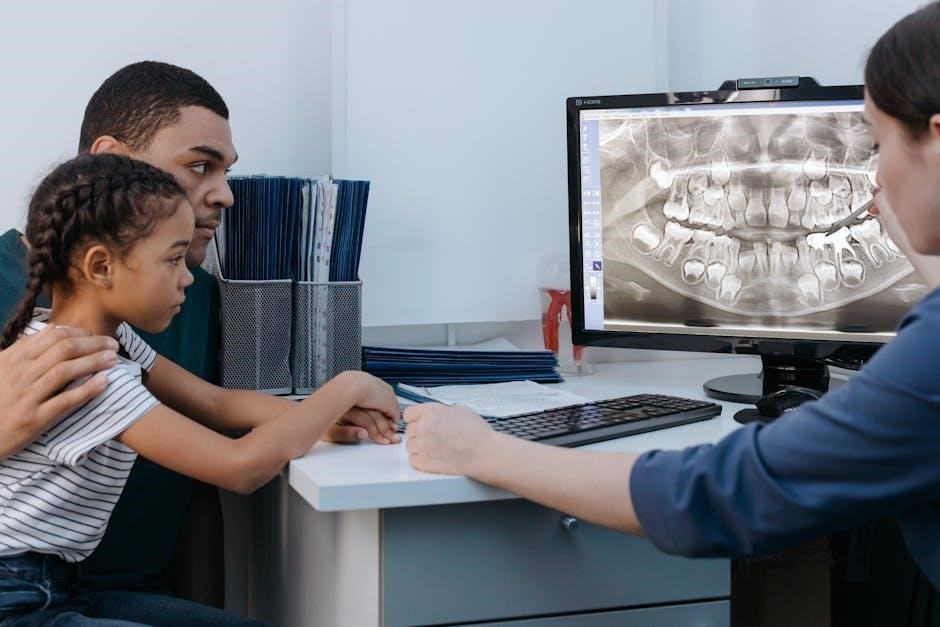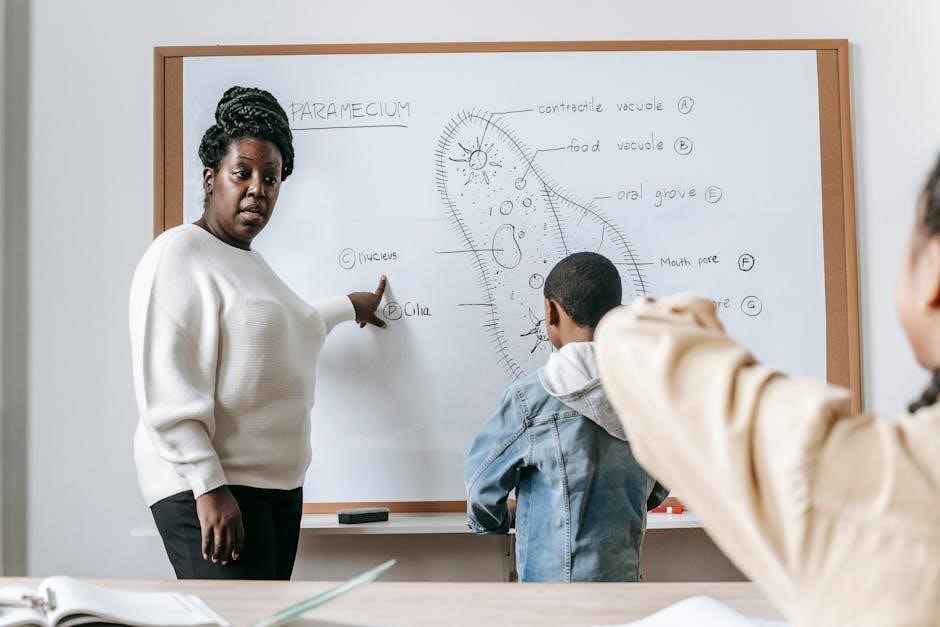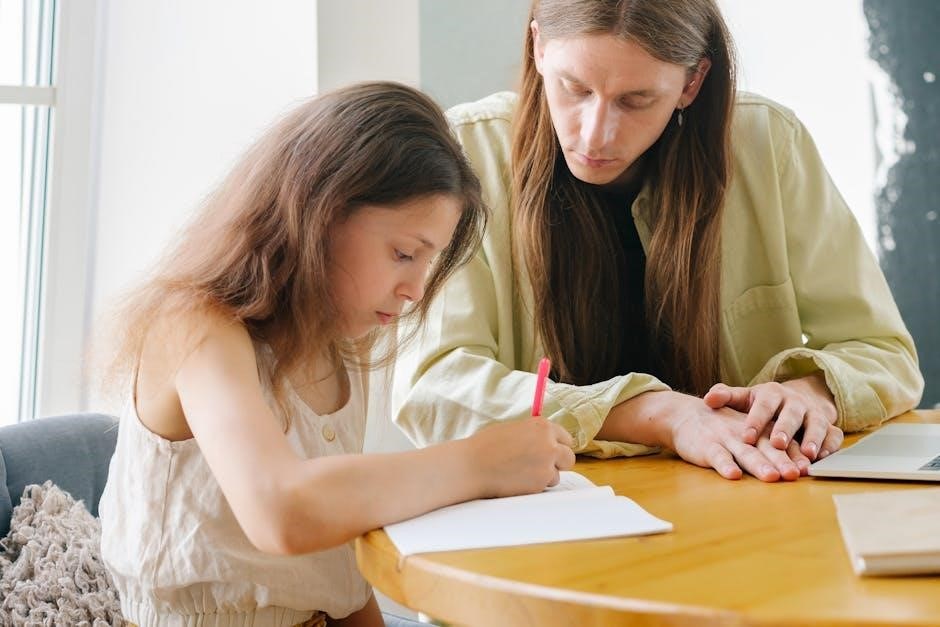
explaining adhd to a child pdf
Explaining ADHD to a child requires simplicity, empathy, and positivity. Use relatable language to help them understand their experiences, strengths, and challenges. Always emphasize that ADHD is just one part of who they are. This approach fosters acceptance and confidence, helping them thrive in a supportive environment.
Why It’s Important to Explain ADHD in Simple Terms
Explaining ADHD in simple terms reduces confusion and stigma, helping children understand their experiences without feeling defined by the condition. Using clear, relatable language fosters acceptance and self-awareness, empowering them to embrace their strengths and challenges. Simple explanations also help children grasp how ADHD affects their focus, behavior, and emotions, demystifying their daily struggles. This clarity builds a foundation for open conversations and supports their emotional well-being. By avoiding complex jargon, you ensure the information is accessible and reassuring, helping them feel understood and valued. This approach encourages a positive self-image and prepares them to advocate for themselves as they grow.
Creating a Safe and Non-Judgmental Environment for the Conversation
Creating a safe and non-judgmental environment is crucial when explaining ADHD to a child. Choose a calm, quiet moment where your child feels comfortable and secure. Use positive language and reassure them that it’s okay to ask questions or express feelings. Avoid blame or criticism, focusing instead on understanding and support. Encourage open dialogue by actively listening and showing empathy. This approach helps your child feel accepted and valued, fostering trust and openness. A non-judgmental space allows them to process the information without fear of being criticized, making the conversation more meaningful and effective. This environment lays the foundation for ongoing, supportive communication about their ADHD journey.
Using Relatable Language and Analogies
Using relatable language and analogies is key to helping a child understand ADHD. Compare their brain to a “busy, fast-moving computer” with lots of tabs open, making it hard to focus. Explain that their brain works differently, not better or worse. Use examples they can relate to, like a race car engine always running or a superhero with extra energy. These analogies make complex concepts simple and engaging. Highlight their strengths, such as creativity or enthusiasm, to balance the conversation; Avoid overly technical terms and keep explanations positive and empowering. This approach helps them feel understood and valued, fostering a sense of control and confidence in managing their ADHD.

Understanding ADHD Basics
ADHD is a medical condition affecting attention, self-control, and hyperactivity. It impacts brain function, making it harder to focus, sit still, or regulate impulses.
What ADHD Is and How It Affects the Brain
ADHD is a neurodevelopmental disorder affecting attention, behavior, and activity levels. It impacts the brain’s executive function, making it harder to focus, organize, and regulate impulses.
Children with ADHD may struggle with sustained attention, sitting still, or controlling hyperactive behaviors. The brain’s prefrontal cortex, responsible for planning and self-control, works differently in individuals with ADHD.
This difference can lead to challenges in filtering distractions, managing time, and completing tasks. ADHD is not a result of poor parenting or lack of effort but is rooted in brain structure and function.
Understanding this helps reduce stigma and fosters empathy. By explaining ADHD as a medical condition with genetic and environmental factors, children can better grasp their experiences.
The Difference Between ADD and ADHD
ADD (Attention Deficit Disorder) and ADHD (Attention-Deficit/Hyperactivity Disorder) are often confused but have key differences. ADD, now referred to as ADHD-Inattentive Type, primarily affects focus and organization without hyperactivity.
ADHD includes symptoms of hyperactivity and impulsivity, which are not present in ADD. Both are neurodevelopmental disorders impacting attention and self-regulation but manifest differently.
Explaining this distinction helps children understand their specific challenges. For example, a child with ADD might struggle to stay focused, while a child with ADHD may also fidget or act impulsively.
Both conditions require tailored strategies to help children manage their unique symptoms effectively. Understanding the difference is crucial for providing the right support.
Common Symptoms and How They Manifest in Children
Children with ADHD often exhibit symptoms like difficulty staying focused, impulsivity, and excessive energy. They might struggle to complete tasks, listen when spoken to, or wait their turn.
Some children may appear constantly “on the go,” fidget, or talk excessively. Others might have trouble organizing their thoughts or belongings. Emotional regulation can also be challenging, leading to frustration or impulsive actions.
These behaviors are not a matter of choice but rather how their brain works. Understanding these symptoms helps children recognize what they’re experiencing and feel less confused or ashamed. Open conversations about these challenges can foster empathy and encourage seeking strategies to manage them effectively.

Explaining ADHD to Your Child
Explaining ADHD to your child involves using simple, positive language to describe their unique brain and strengths. Emphasize that ADHD is just one part of who they are.
Using Simple Analogies to Describe ADHD
Using simple analogies helps children understand ADHD in relatable ways. For example, compare their brain to a busy highway with many cars (thoughts) moving fast, making it hard to focus. Another analogy is a race car engine that sometimes goes too fast, making it difficult to sit still. These examples help illustrate how ADHD affects attention and behavior without overwhelming them. Emphasize that their brain is unique and capable, just wired differently. This approach fosters understanding, reduces confusion, and helps them feel more comfortable with their experiences. Always pair analogies with reassurance and positivity to build confidence and self-acceptance. These tools make complex concepts accessible and empowering for children.
Focusing on Strengths and Positive Traits
Focusing on strengths and positive traits is essential when explaining ADHD to a child. Highlighting their creativity, energy, and unique problem-solving skills helps build confidence and self-esteem. Emphasize how these traits can be advantageous in various situations. Encourage children to embrace their differences and recognize their potential. Parents should identify and praise their child’s strengths regularly, support their interests, and teach practical coping strategies. By fostering a positive mindset, children with ADHD can learn to view their condition as a part of their identity without defining them. This approach helps them grow into resilient and capable individuals.
Emphasizing That ADHD Is Not a Definition of Who They Are
It’s crucial to explain that ADHD is just one part of who they are—it doesn’t define their worth or potential. Help your child understand that everyone has unique qualities, and ADHD is just one aspect of their identity. Emphasize their strengths, talents, and positive traits, such as creativity, energy, or kindness. Encourage them to see themselves as whole individuals, not solely through the lens of ADHD. Reassure them that having ADHD doesn’t make them flawed or less capable. Foster a mindset that focuses on growth, resilience, and self-acceptance. By doing so, you help them build a strong sense of self and confidence in their abilities.

Addressing Common Questions and Concerns
Addressing common questions and concerns helps your child feel understood and supported. Explain that ADHD is a medical condition, not a choice, and it’s okay to face challenges. Reassure them that they’re not alone and that help is available. Focus on fostering openness and providing clear, age-appropriate answers to their questions about focus, behavior, and emotions.
Why ADHD Makes It Hard to Focus or Sit Still
ADHD affects the brain’s ability to regulate attention and activity levels. Imagine their brain as a busy road with too many cars trying to move at once—it’s hard to focus on just one thing. This makes it difficult for them to sit still or concentrate, not because they’re being disobedient, but because their brain works differently. It’s not their fault; it’s how their brain is wired. This explanation helps them understand that it’s a medical condition, not a choice. By framing it this way, you normalize their experiences and open the door to discussing strategies for managing these challenges together.
How ADHD Affects Behavior and Decision-Making
ADHD can make it harder for children to control their impulses and make thoughtful decisions. Imagine their brain as a control panel with buttons that sometimes work too fast or not at all. This can lead to actions without thinking, like interrupting others or acting impulsively. It’s not that they’re being naughty—it’s their brain’s way of handling situations. Decision-making can also be challenging because their mind might jump between ideas quickly. Explaining this in simple terms helps them understand it’s not their fault and that strategies like taking deep breaths or counting to ten can help them manage these moments better.
Explaining That ADHD Is a Medical Condition, Not a Choice
ADHD is a medical condition that affects the brain, making it harder for children to focus, sit still, or control impulses. It’s not something they can choose to change or control on their own. Comparing it to wearing glasses for vision can help them understand—it’s a way to help their brain work more effectively. Emphasize that ADHD is not their fault and doesn’t mean they’re bad or lazy. This reassurance helps reduce feelings of shame and builds acceptance. By explaining it as a medical condition, children can better understand their challenges and feel more confident in seeking support and strategies to manage their ADHD.

Strategies for Helping Your Child Understand ADHD
Encourage open conversations, use visual aids, and simple analogies to explain ADHD. Foster curiosity and celebrate strengths to build confidence and understanding.
Encouraging Open Conversations and Questions
Creating a safe space for open dialogue is crucial when explaining ADHD to a child. Encourage them to ask questions and express their feelings without fear of judgment. Listen actively to their concerns and validate their experiences. This fosters trust and understanding, helping them feel comfortable discussing their challenges and strengths. By promoting open conversations, you empower your child to seek clarity and develop a positive self-image. Regular check-ins and honest discussions can also help them process emotions and build resilience. Always reassure them that it’s okay to ask for help and that they are supported every step of the way.
Using Visual Aids or Diagrams to Explain ADHD
Visual aids and diagrams are powerful tools for helping children understand ADHD. Simple illustrations can explain complex concepts like how the brain works differently or what happens when focus is hard to maintain. For example, using a puzzle piece to represent ADHD as one part of their unique brain can make the idea relatable. Diagrams showing how medication or strategies help can also clarify the process. Visual aids like charts or infographics can break down information into digestible parts, making it easier for children to grasp and remember. This approach engages their visual learning style and helps them connect abstract ideas to everyday experiences, fostering a clearer understanding of their ADHD.
Sharing Stories or Videos Featuring Children with ADHD
Sharing stories or videos featuring children with ADHD can help your child feel understood and less alone. Relatable characters in these stories often face similar challenges, making the experience more tangible. Videos, especially those co-produced by children with ADHD, offer authentic perspectives and practical explanations. These resources can also highlight strengths and successes, showcasing how others manage their ADHD. By seeing others in similar situations, your child can gain empathy and hope, realizing that they are part of a larger community. This shared experience fosters a sense of belonging and encourages open conversations about their own feelings and experiences with ADHD.

The Role of Parents and Caregivers
Parents and caregivers play a vital role in providing emotional support, reassurance, and guidance. They help children understand ADHD, develop coping strategies, and navigate daily challenges with confidence.
Providing Emotional Support and Reassurance
Providing emotional support and reassurance is crucial for a child with ADHD. Parents and caregivers should create a safe, non-judgmental space where the child feels valued and understood. Using positive language and focusing on their strengths helps build confidence. Reassure them that ADHD is not a defect but a part of their unique brain function. Encourage open conversations where they can express feelings without fear of criticism. Acknowledge their challenges and celebrate small victories to foster resilience. Unconditional support and understanding help the child develop self-acceptance and a positive self-image, which are essential for their emotional well-being and growth.
Helping Your Child Develop Coping Strategies
Helping your child develop coping strategies is essential for managing ADHD. Start by identifying their strengths and challenges, then introduce practical tools like daily routines, task lists, or reminders. Encourage problem-solving skills by guiding them to break tasks into smaller steps. Teach mindfulness techniques or deep breathing exercises to manage impulsivity and emotions. Positive reinforcement, such as praise or rewards, can motivate them to use these strategies consistently. Be patient and consistent, as developing new habits takes time. By fostering independence and self-regulation, you empower your child to navigate challenges confidently, building their resilience and self-esteem over time.
Explaining the Importance of Diagnosis and Treatment
Explaining the importance of diagnosis and treatment helps your child understand why certain strategies or therapies are necessary. A proper diagnosis ensures that their symptoms are accurately identified, allowing for tailored support. Treatment, such as therapy or medication, can help manage ADHD symptoms, improving focus and behavior. Emphasize that diagnosis and treatment are tools to help them thrive, not something to be ashamed of. By addressing their challenges, your child can better navigate school, friendships, and daily life. This approach fosters a positive outlook and empowers them to take control of their well-being, knowing they have the support they need to succeed.

Creating a Positive and Supportive Environment
Foster a positive environment by encouraging open conversations, patience, and understanding. Celebrate strengths and progress, helping your child feel empowered and valued. This supports their confidence and growth.
Building Self-Esteem and Confidence
Building self-esteem in children with ADHD involves acknowledging their strengths and talents. Encourage positive reinforcement by praising their efforts and progress. Help them set realistic goals and celebrate achievements, fostering resilience and confidence. Teach them to view challenges as opportunities for growth, rather than failures. Engage them in activities they enjoy, allowing them to feel competent and proud. Positive language and support from caregivers can significantly enhance their self-image; By focusing on their unique qualities and accomplishments, you help them develop a strong sense of self-worth and confidence to navigate life’s challenges effectively.
Celebrating Small Victories and Progress
Celebrating Small Victories and Progress
Celebrating small victories helps children with ADHD build confidence and motivation. Acknowledge their efforts, no matter how minor, to reinforce positive behavior. Progress, not perfection, is key. Use specific praise to highlight achievements, encouraging a growth mindset. This approach fosters resilience and self-esteem, helping them recognize their capabilities. Celebrating milestones creates a positive environment where they feel valued and supported, promoting overall development and well-being.

Encouraging Social Interactions and Friendships
Children with ADHD often face challenges in social interactions due to difficulties with focus, impulsivity, or interpreting social cues. Encouraging positive friendships is crucial for their emotional and social development. Parents can help by modeling healthy communication, teaching empathy, and fostering shared activities. Playdates in small, structured settings can reduce overwhelm and promote connection. Encouraging teamwork or group hobbies helps build cooperation skills. Celebrating social successes, no matter how small, reinforces positive behavior. Providing guidance on reading social cues and managing impulses can also enhance their ability to form meaningful friendships. Supporting their social growth helps them build lasting relationships and a stronger sense of belonging.

Additional Resources for Children and Parents
Explore recommended books, online videos, and animations that explain ADHD in engaging ways for children. Support groups and resources also help parents and kids understand and manage ADHD effectively.
Recommended Books and Guides for Kids

Engaging books like “All Dogs Have ADHD” and “My Brother’s a Superhero” use relatable stories to explain ADHD in a child-friendly way. These resources help kids understand their experiences and feel less alone. Guides such as “Understanding My ADHD” offer simple, visual explanations, making complex concepts accessible. Books like “ADHD Explained” provide reassurance, emphasizing strengths and positive traits. These materials are designed to open conversations and foster acceptance, helping children build confidence and self-esteem. By sharing these stories, parents can create a supportive environment where their child feels understood and empowered to thrive.
Online Videos and Animations Explaining ADHD
Online videos and animations are powerful tools for helping children understand ADHD. Engaging animations, like those featuring characters with ADHD, make complex concepts relatable. Videos such as “What Is ADHD?” explain how the brain works differently, using simple language. Animated stories, like one about a girl managing her ADHD, show real-life challenges and solutions. These resources also address topics like sensory sensitivities and emotional dysregulation in an accessible way. Many videos are designed for older, science-minded kids, explaining how medication works or how to cope with symptoms. These visual aids reduce stigma and make ADHD more relatable, helping children feel understood and empowered to ask questions.
Support Groups for Children and Families
Support groups provide a safe space for children with ADHD and their families to connect and share experiences. These groups offer understanding and practical advice, helping families navigate challenges together. Many organizations host sessions tailored for children, where they can participate in activities and discussions with peers who face similar experiences. Parents also benefit from gaining insights and strategies for supporting their child. These groups foster a sense of community, reducing feelings of isolation. They often include expert guidance, emotional support, and resources to help families thrive. Participating in support groups can empower children and families to better understand ADHD while building resilience and confidence.
Related Posts

acls exam version c answers pdf
Get ACLS Exam Version C answers in PDF format. Free study guide, practice questions, and instant download. Prepare smarter, not harder!

john paul jackson books pdf free download
Access John Paul Jackson’s books for free in PDF. Instantly download his spiritual teachings and revelations.

bass arpeggios pdf
Master essential bass arpeggio patterns with our free PDF guide. Boost your skills and take your playing to the next level!